NS3320 - Community Care: Nursing Solutions for Collinsville's Health
VerifiedAdded on 2023/06/04
|7
|1659
|74
Report
AI Summary
This report identifies respiratory health problems in Collinsville, Queensland, Australia, as the most pressing health issue due to coal mining activities. It discusses the link between coal mining and respiratory diseases like chronic bronchitis and emphysema, supported by research highlighting air pollution and its impact on health. The proposed solution involves a risk mitigation framework including precautionary measures like engineering inspections to control coal dust emission, increased medical surveillance using respiratory questionnaires and lung function tests, and remedial measures such as providing personal protective equipment and education. The report emphasizes engineering controls and medical surveillance as key to improving the health and well-being of the Collinsville community.
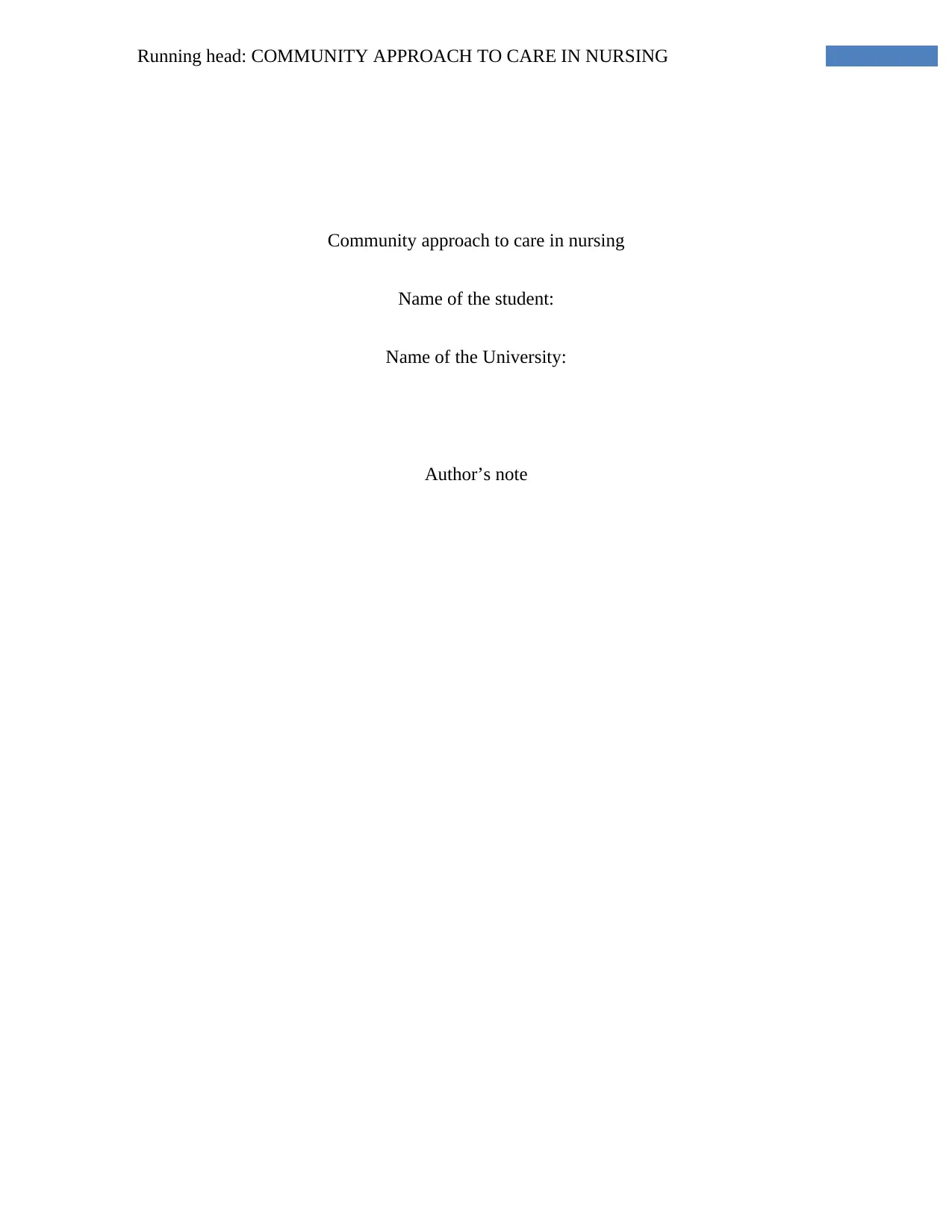
Running head: COMMUNITY APPROACH TO CARE IN NURSING
Community approach to care in nursing
Name of the student:
Name of the University:
Author’s note
Community approach to care in nursing
Name of the student:
Name of the University:
Author’s note
Paraphrase This Document
Need a fresh take? Get an instant paraphrase of this document with our AI Paraphraser
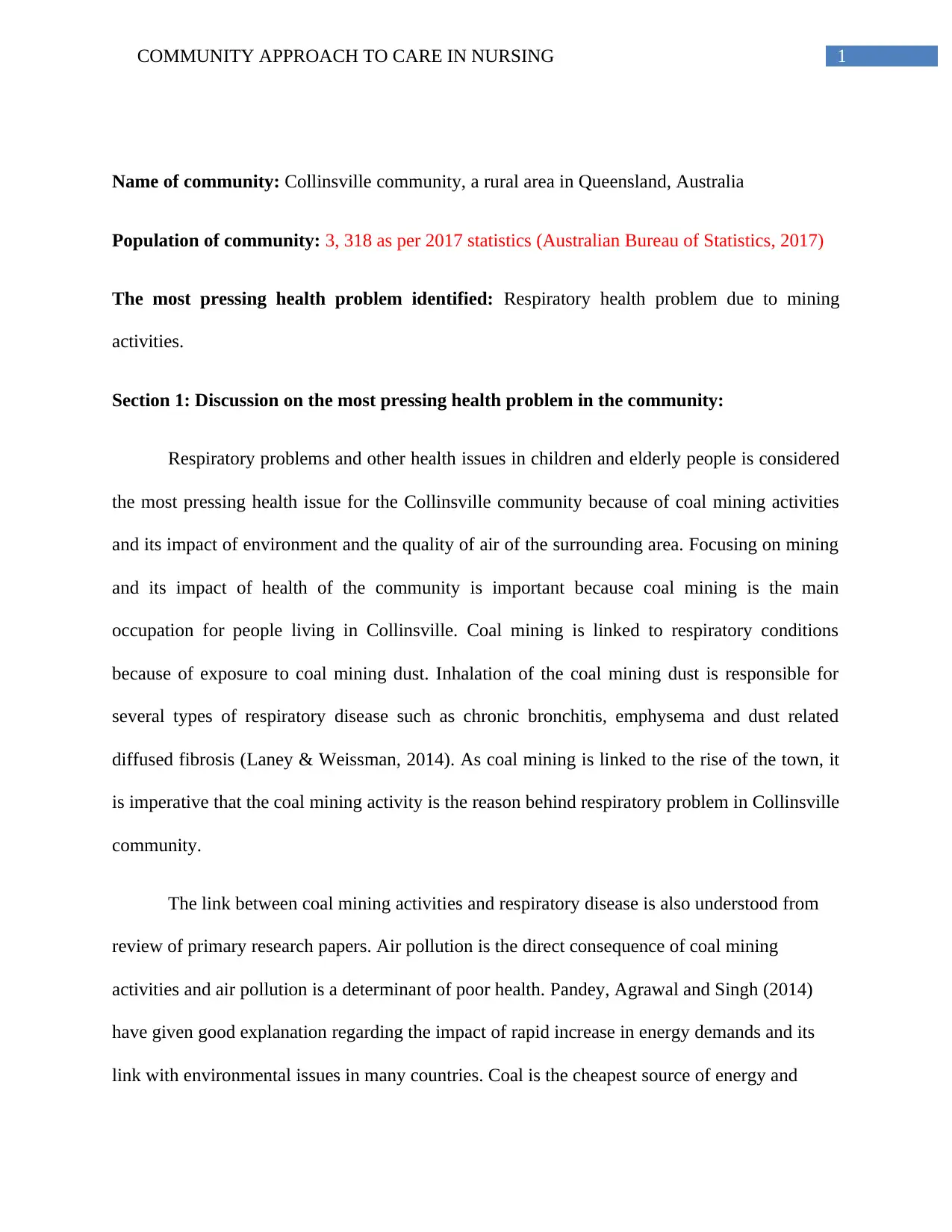
1COMMUNITY APPROACH TO CARE IN NURSING
Name of community: Collinsville community, a rural area in Queensland, Australia
Population of community: 3, 318 as per 2017 statistics (Australian Bureau of Statistics, 2017)
The most pressing health problem identified: Respiratory health problem due to mining
activities.
Section 1: Discussion on the most pressing health problem in the community:
Respiratory problems and other health issues in children and elderly people is considered
the most pressing health issue for the Collinsville community because of coal mining activities
and its impact of environment and the quality of air of the surrounding area. Focusing on mining
and its impact of health of the community is important because coal mining is the main
occupation for people living in Collinsville. Coal mining is linked to respiratory conditions
because of exposure to coal mining dust. Inhalation of the coal mining dust is responsible for
several types of respiratory disease such as chronic bronchitis, emphysema and dust related
diffused fibrosis (Laney & Weissman, 2014). As coal mining is linked to the rise of the town, it
is imperative that the coal mining activity is the reason behind respiratory problem in Collinsville
community.
The link between coal mining activities and respiratory disease is also understood from
review of primary research papers. Air pollution is the direct consequence of coal mining
activities and air pollution is a determinant of poor health. Pandey, Agrawal and Singh (2014)
have given good explanation regarding the impact of rapid increase in energy demands and its
link with environmental issues in many countries. Coal is the cheapest source of energy and
Name of community: Collinsville community, a rural area in Queensland, Australia
Population of community: 3, 318 as per 2017 statistics (Australian Bureau of Statistics, 2017)
The most pressing health problem identified: Respiratory health problem due to mining
activities.
Section 1: Discussion on the most pressing health problem in the community:
Respiratory problems and other health issues in children and elderly people is considered
the most pressing health issue for the Collinsville community because of coal mining activities
and its impact of environment and the quality of air of the surrounding area. Focusing on mining
and its impact of health of the community is important because coal mining is the main
occupation for people living in Collinsville. Coal mining is linked to respiratory conditions
because of exposure to coal mining dust. Inhalation of the coal mining dust is responsible for
several types of respiratory disease such as chronic bronchitis, emphysema and dust related
diffused fibrosis (Laney & Weissman, 2014). As coal mining is linked to the rise of the town, it
is imperative that the coal mining activity is the reason behind respiratory problem in Collinsville
community.
The link between coal mining activities and respiratory disease is also understood from
review of primary research papers. Air pollution is the direct consequence of coal mining
activities and air pollution is a determinant of poor health. Pandey, Agrawal and Singh (2014)
have given good explanation regarding the impact of rapid increase in energy demands and its
link with environmental issues in many countries. Coal is the cheapest source of energy and
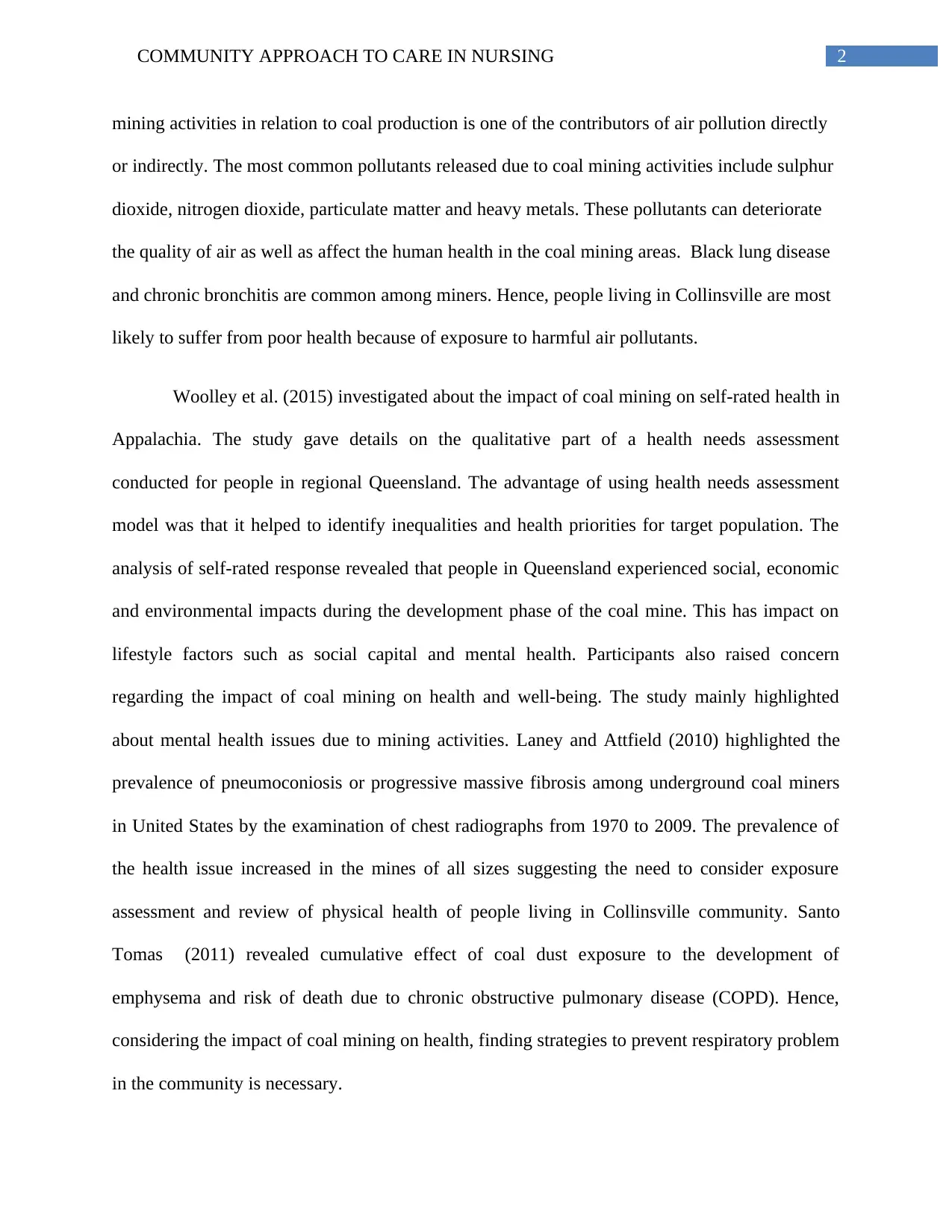
2COMMUNITY APPROACH TO CARE IN NURSING
mining activities in relation to coal production is one of the contributors of air pollution directly
or indirectly. The most common pollutants released due to coal mining activities include sulphur
dioxide, nitrogen dioxide, particulate matter and heavy metals. These pollutants can deteriorate
the quality of air as well as affect the human health in the coal mining areas. Black lung disease
and chronic bronchitis are common among miners. Hence, people living in Collinsville are most
likely to suffer from poor health because of exposure to harmful air pollutants.
Woolley et al. (2015) investigated about the impact of coal mining on self-rated health in
Appalachia. The study gave details on the qualitative part of a health needs assessment
conducted for people in regional Queensland. The advantage of using health needs assessment
model was that it helped to identify inequalities and health priorities for target population. The
analysis of self-rated response revealed that people in Queensland experienced social, economic
and environmental impacts during the development phase of the coal mine. This has impact on
lifestyle factors such as social capital and mental health. Participants also raised concern
regarding the impact of coal mining on health and well-being. The study mainly highlighted
about mental health issues due to mining activities. Laney and Attfield (2010) highlighted the
prevalence of pneumoconiosis or progressive massive fibrosis among underground coal miners
in United States by the examination of chest radiographs from 1970 to 2009. The prevalence of
the health issue increased in the mines of all sizes suggesting the need to consider exposure
assessment and review of physical health of people living in Collinsville community. Santo
Tomas (2011) revealed cumulative effect of coal dust exposure to the development of
emphysema and risk of death due to chronic obstructive pulmonary disease (COPD). Hence,
considering the impact of coal mining on health, finding strategies to prevent respiratory problem
in the community is necessary.
mining activities in relation to coal production is one of the contributors of air pollution directly
or indirectly. The most common pollutants released due to coal mining activities include sulphur
dioxide, nitrogen dioxide, particulate matter and heavy metals. These pollutants can deteriorate
the quality of air as well as affect the human health in the coal mining areas. Black lung disease
and chronic bronchitis are common among miners. Hence, people living in Collinsville are most
likely to suffer from poor health because of exposure to harmful air pollutants.
Woolley et al. (2015) investigated about the impact of coal mining on self-rated health in
Appalachia. The study gave details on the qualitative part of a health needs assessment
conducted for people in regional Queensland. The advantage of using health needs assessment
model was that it helped to identify inequalities and health priorities for target population. The
analysis of self-rated response revealed that people in Queensland experienced social, economic
and environmental impacts during the development phase of the coal mine. This has impact on
lifestyle factors such as social capital and mental health. Participants also raised concern
regarding the impact of coal mining on health and well-being. The study mainly highlighted
about mental health issues due to mining activities. Laney and Attfield (2010) highlighted the
prevalence of pneumoconiosis or progressive massive fibrosis among underground coal miners
in United States by the examination of chest radiographs from 1970 to 2009. The prevalence of
the health issue increased in the mines of all sizes suggesting the need to consider exposure
assessment and review of physical health of people living in Collinsville community. Santo
Tomas (2011) revealed cumulative effect of coal dust exposure to the development of
emphysema and risk of death due to chronic obstructive pulmonary disease (COPD). Hence,
considering the impact of coal mining on health, finding strategies to prevent respiratory problem
in the community is necessary.
⊘ This is a preview!⊘
Do you want full access?
Subscribe today to unlock all pages.

Trusted by 1+ million students worldwide
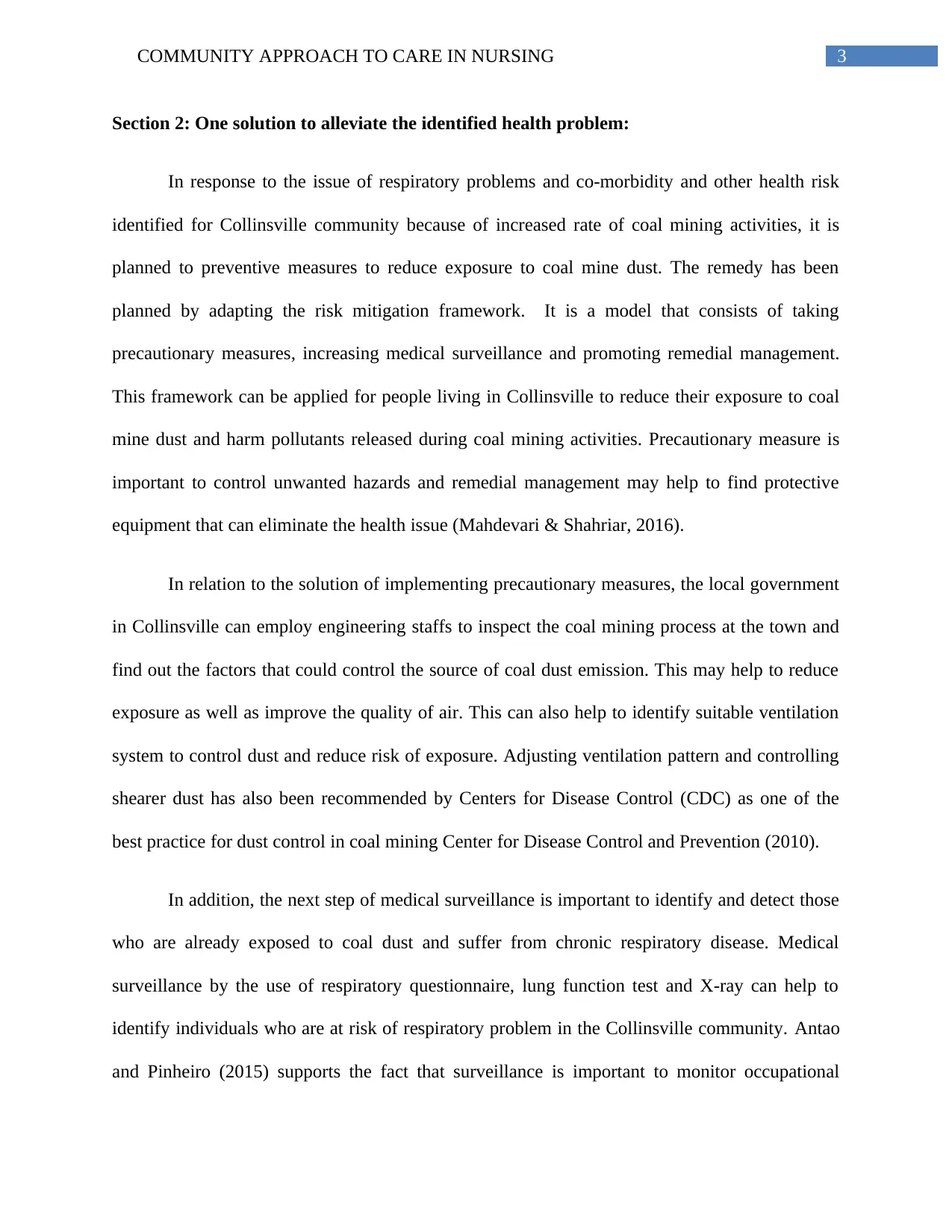
3COMMUNITY APPROACH TO CARE IN NURSING
Section 2: One solution to alleviate the identified health problem:
In response to the issue of respiratory problems and co-morbidity and other health risk
identified for Collinsville community because of increased rate of coal mining activities, it is
planned to preventive measures to reduce exposure to coal mine dust. The remedy has been
planned by adapting the risk mitigation framework. It is a model that consists of taking
precautionary measures, increasing medical surveillance and promoting remedial management.
This framework can be applied for people living in Collinsville to reduce their exposure to coal
mine dust and harm pollutants released during coal mining activities. Precautionary measure is
important to control unwanted hazards and remedial management may help to find protective
equipment that can eliminate the health issue (Mahdevari & Shahriar, 2016).
In relation to the solution of implementing precautionary measures, the local government
in Collinsville can employ engineering staffs to inspect the coal mining process at the town and
find out the factors that could control the source of coal dust emission. This may help to reduce
exposure as well as improve the quality of air. This can also help to identify suitable ventilation
system to control dust and reduce risk of exposure. Adjusting ventilation pattern and controlling
shearer dust has also been recommended by Centers for Disease Control (CDC) as one of the
best practice for dust control in coal mining Center for Disease Control and Prevention (2010).
In addition, the next step of medical surveillance is important to identify and detect those
who are already exposed to coal dust and suffer from chronic respiratory disease. Medical
surveillance by the use of respiratory questionnaire, lung function test and X-ray can help to
identify individuals who are at risk of respiratory problem in the Collinsville community. Antao
and Pinheiro (2015) supports the fact that surveillance is important to monitor occupational
Section 2: One solution to alleviate the identified health problem:
In response to the issue of respiratory problems and co-morbidity and other health risk
identified for Collinsville community because of increased rate of coal mining activities, it is
planned to preventive measures to reduce exposure to coal mine dust. The remedy has been
planned by adapting the risk mitigation framework. It is a model that consists of taking
precautionary measures, increasing medical surveillance and promoting remedial management.
This framework can be applied for people living in Collinsville to reduce their exposure to coal
mine dust and harm pollutants released during coal mining activities. Precautionary measure is
important to control unwanted hazards and remedial management may help to find protective
equipment that can eliminate the health issue (Mahdevari & Shahriar, 2016).
In relation to the solution of implementing precautionary measures, the local government
in Collinsville can employ engineering staffs to inspect the coal mining process at the town and
find out the factors that could control the source of coal dust emission. This may help to reduce
exposure as well as improve the quality of air. This can also help to identify suitable ventilation
system to control dust and reduce risk of exposure. Adjusting ventilation pattern and controlling
shearer dust has also been recommended by Centers for Disease Control (CDC) as one of the
best practice for dust control in coal mining Center for Disease Control and Prevention (2010).
In addition, the next step of medical surveillance is important to identify and detect those
who are already exposed to coal dust and suffer from chronic respiratory disease. Medical
surveillance by the use of respiratory questionnaire, lung function test and X-ray can help to
identify individuals who are at risk of respiratory problem in the Collinsville community. Antao
and Pinheiro (2015) supports the fact that surveillance is important to monitor occupational
Paraphrase This Document
Need a fresh take? Get an instant paraphrase of this document with our AI Paraphraser
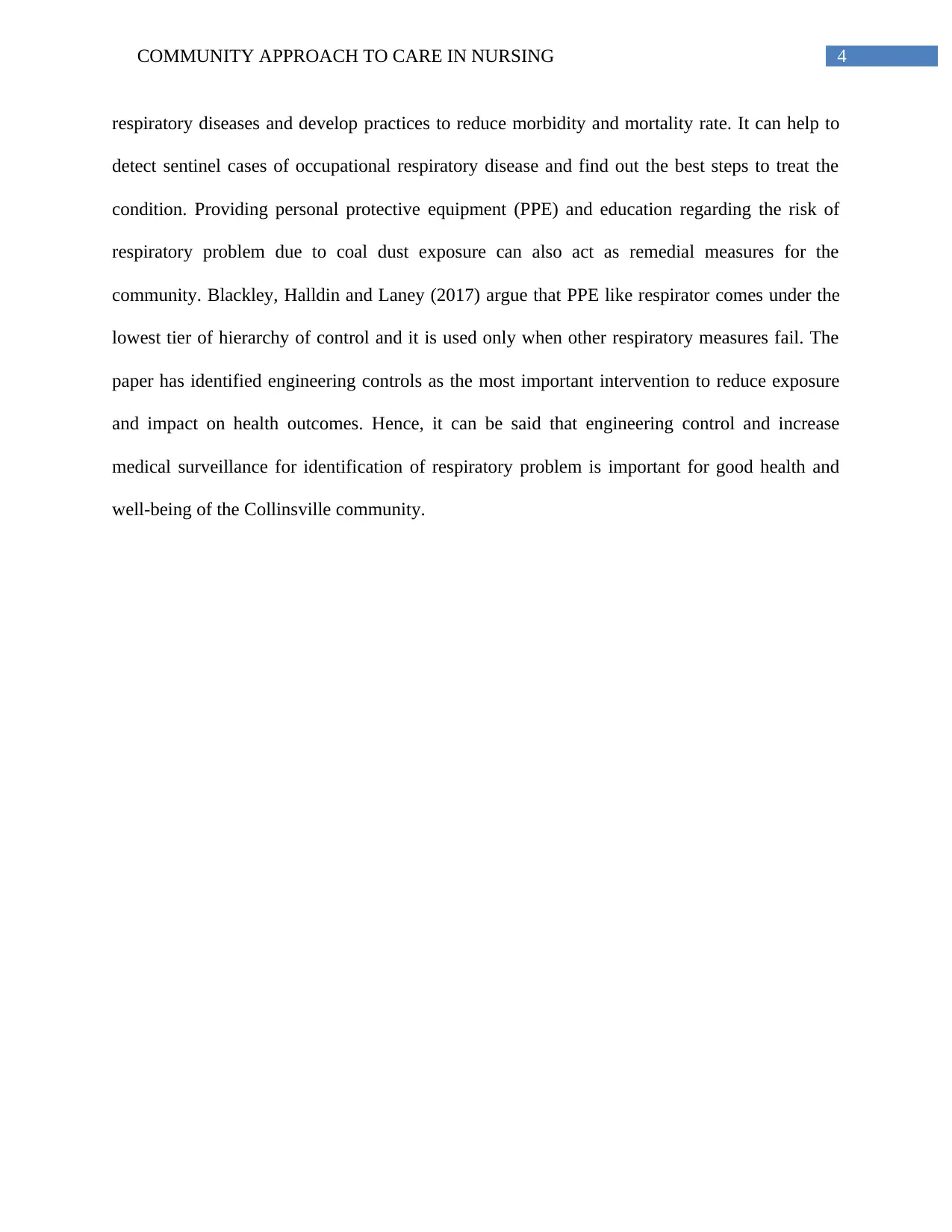
4COMMUNITY APPROACH TO CARE IN NURSING
respiratory diseases and develop practices to reduce morbidity and mortality rate. It can help to
detect sentinel cases of occupational respiratory disease and find out the best steps to treat the
condition. Providing personal protective equipment (PPE) and education regarding the risk of
respiratory problem due to coal dust exposure can also act as remedial measures for the
community. Blackley, Halldin and Laney (2017) argue that PPE like respirator comes under the
lowest tier of hierarchy of control and it is used only when other respiratory measures fail. The
paper has identified engineering controls as the most important intervention to reduce exposure
and impact on health outcomes. Hence, it can be said that engineering control and increase
medical surveillance for identification of respiratory problem is important for good health and
well-being of the Collinsville community.
respiratory diseases and develop practices to reduce morbidity and mortality rate. It can help to
detect sentinel cases of occupational respiratory disease and find out the best steps to treat the
condition. Providing personal protective equipment (PPE) and education regarding the risk of
respiratory problem due to coal dust exposure can also act as remedial measures for the
community. Blackley, Halldin and Laney (2017) argue that PPE like respirator comes under the
lowest tier of hierarchy of control and it is used only when other respiratory measures fail. The
paper has identified engineering controls as the most important intervention to reduce exposure
and impact on health outcomes. Hence, it can be said that engineering control and increase
medical surveillance for identification of respiratory problem is important for good health and
well-being of the Collinsville community.
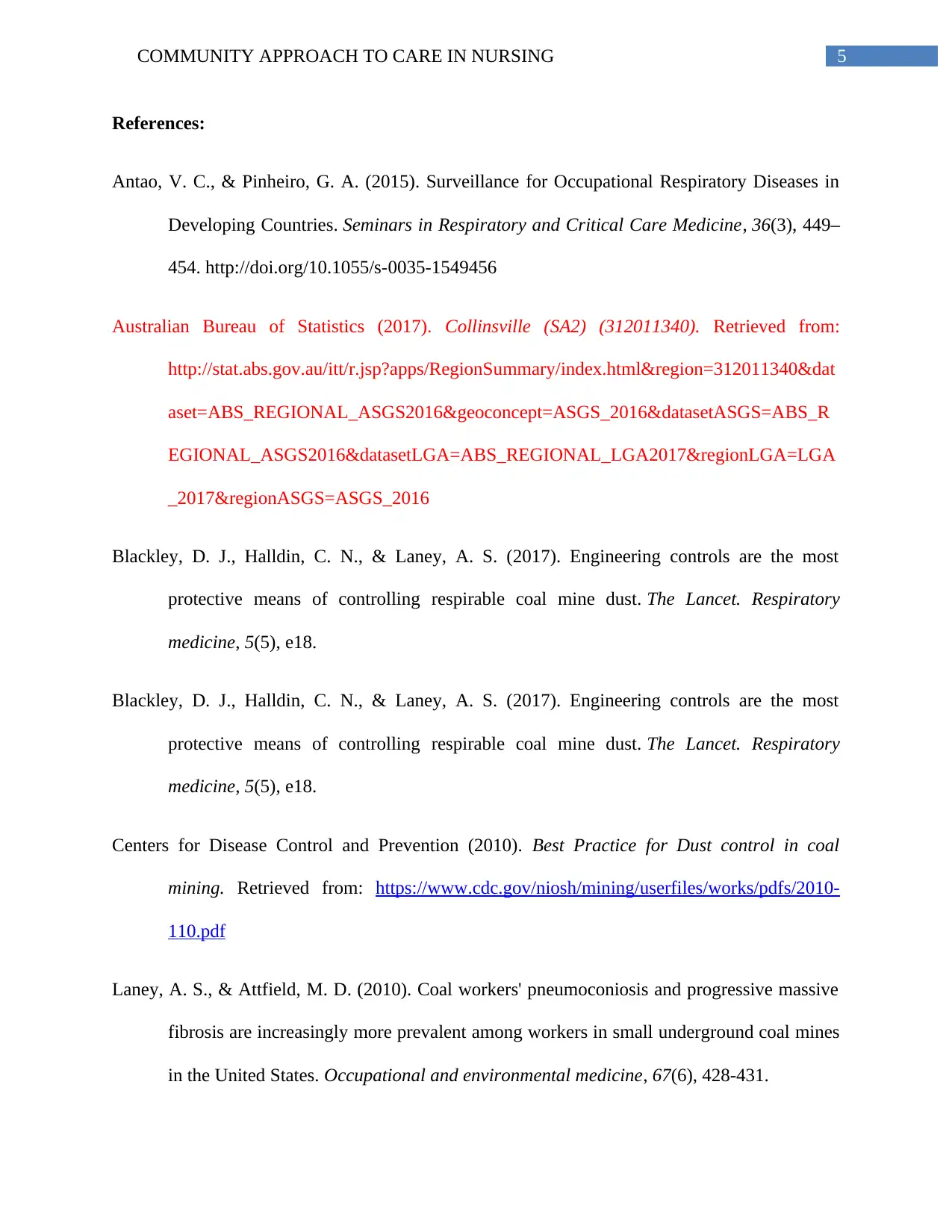
5COMMUNITY APPROACH TO CARE IN NURSING
References:
Antao, V. C., & Pinheiro, G. A. (2015). Surveillance for Occupational Respiratory Diseases in
Developing Countries. Seminars in Respiratory and Critical Care Medicine, 36(3), 449–
454. http://doi.org/10.1055/s-0035-1549456
Australian Bureau of Statistics (2017). Collinsville (SA2) (312011340). Retrieved from:
http://stat.abs.gov.au/itt/r.jsp?apps/RegionSummary/index.html®ion=312011340&dat
aset=ABS_REGIONAL_ASGS2016&geoconcept=ASGS_2016&datasetASGS=ABS_R
EGIONAL_ASGS2016&datasetLGA=ABS_REGIONAL_LGA2017®ionLGA=LGA
_2017®ionASGS=ASGS_2016
Blackley, D. J., Halldin, C. N., & Laney, A. S. (2017). Engineering controls are the most
protective means of controlling respirable coal mine dust. The Lancet. Respiratory
medicine, 5(5), e18.
Blackley, D. J., Halldin, C. N., & Laney, A. S. (2017). Engineering controls are the most
protective means of controlling respirable coal mine dust. The Lancet. Respiratory
medicine, 5(5), e18.
Centers for Disease Control and Prevention (2010). Best Practice for Dust control in coal
mining. Retrieved from: https://www.cdc.gov/niosh/mining/userfiles/works/pdfs/2010-
110.pdf
Laney, A. S., & Attfield, M. D. (2010). Coal workers' pneumoconiosis and progressive massive
fibrosis are increasingly more prevalent among workers in small underground coal mines
in the United States. Occupational and environmental medicine, 67(6), 428-431.
References:
Antao, V. C., & Pinheiro, G. A. (2015). Surveillance for Occupational Respiratory Diseases in
Developing Countries. Seminars in Respiratory and Critical Care Medicine, 36(3), 449–
454. http://doi.org/10.1055/s-0035-1549456
Australian Bureau of Statistics (2017). Collinsville (SA2) (312011340). Retrieved from:
http://stat.abs.gov.au/itt/r.jsp?apps/RegionSummary/index.html®ion=312011340&dat
aset=ABS_REGIONAL_ASGS2016&geoconcept=ASGS_2016&datasetASGS=ABS_R
EGIONAL_ASGS2016&datasetLGA=ABS_REGIONAL_LGA2017®ionLGA=LGA
_2017®ionASGS=ASGS_2016
Blackley, D. J., Halldin, C. N., & Laney, A. S. (2017). Engineering controls are the most
protective means of controlling respirable coal mine dust. The Lancet. Respiratory
medicine, 5(5), e18.
Blackley, D. J., Halldin, C. N., & Laney, A. S. (2017). Engineering controls are the most
protective means of controlling respirable coal mine dust. The Lancet. Respiratory
medicine, 5(5), e18.
Centers for Disease Control and Prevention (2010). Best Practice for Dust control in coal
mining. Retrieved from: https://www.cdc.gov/niosh/mining/userfiles/works/pdfs/2010-
110.pdf
Laney, A. S., & Attfield, M. D. (2010). Coal workers' pneumoconiosis and progressive massive
fibrosis are increasingly more prevalent among workers in small underground coal mines
in the United States. Occupational and environmental medicine, 67(6), 428-431.
⊘ This is a preview!⊘
Do you want full access?
Subscribe today to unlock all pages.

Trusted by 1+ million students worldwide
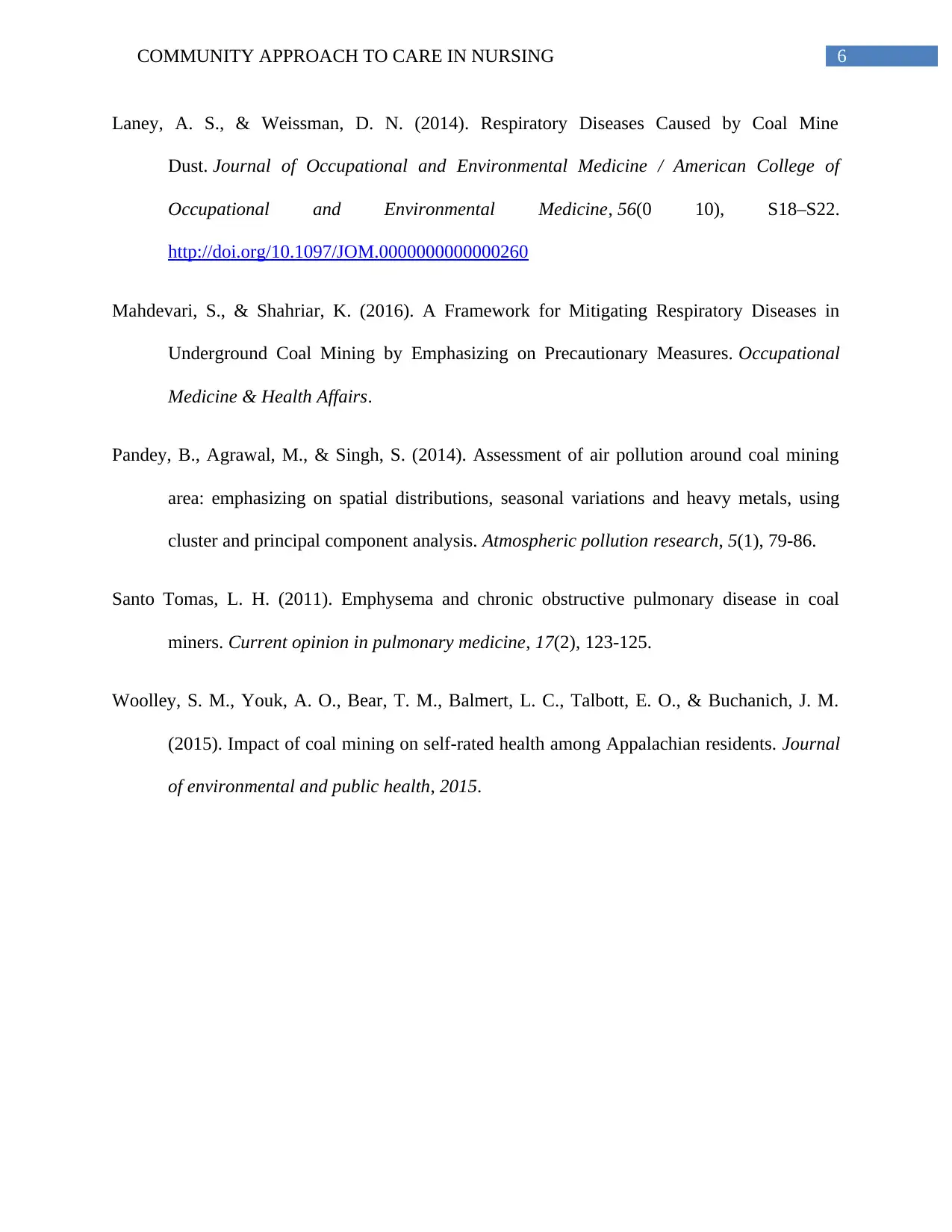
6COMMUNITY APPROACH TO CARE IN NURSING
Laney, A. S., & Weissman, D. N. (2014). Respiratory Diseases Caused by Coal Mine
Dust. Journal of Occupational and Environmental Medicine / American College of
Occupational and Environmental Medicine, 56(0 10), S18–S22.
http://doi.org/10.1097/JOM.0000000000000260
Mahdevari, S., & Shahriar, K. (2016). A Framework for Mitigating Respiratory Diseases in
Underground Coal Mining by Emphasizing on Precautionary Measures. Occupational
Medicine & Health Affairs.
Pandey, B., Agrawal, M., & Singh, S. (2014). Assessment of air pollution around coal mining
area: emphasizing on spatial distributions, seasonal variations and heavy metals, using
cluster and principal component analysis. Atmospheric pollution research, 5(1), 79-86.
Santo Tomas, L. H. (2011). Emphysema and chronic obstructive pulmonary disease in coal
miners. Current opinion in pulmonary medicine, 17(2), 123-125.
Woolley, S. M., Youk, A. O., Bear, T. M., Balmert, L. C., Talbott, E. O., & Buchanich, J. M.
(2015). Impact of coal mining on self-rated health among Appalachian residents. Journal
of environmental and public health, 2015.
Laney, A. S., & Weissman, D. N. (2014). Respiratory Diseases Caused by Coal Mine
Dust. Journal of Occupational and Environmental Medicine / American College of
Occupational and Environmental Medicine, 56(0 10), S18–S22.
http://doi.org/10.1097/JOM.0000000000000260
Mahdevari, S., & Shahriar, K. (2016). A Framework for Mitigating Respiratory Diseases in
Underground Coal Mining by Emphasizing on Precautionary Measures. Occupational
Medicine & Health Affairs.
Pandey, B., Agrawal, M., & Singh, S. (2014). Assessment of air pollution around coal mining
area: emphasizing on spatial distributions, seasonal variations and heavy metals, using
cluster and principal component analysis. Atmospheric pollution research, 5(1), 79-86.
Santo Tomas, L. H. (2011). Emphysema and chronic obstructive pulmonary disease in coal
miners. Current opinion in pulmonary medicine, 17(2), 123-125.
Woolley, S. M., Youk, A. O., Bear, T. M., Balmert, L. C., Talbott, E. O., & Buchanich, J. M.
(2015). Impact of coal mining on self-rated health among Appalachian residents. Journal
of environmental and public health, 2015.
1 out of 7
Related Documents
Your All-in-One AI-Powered Toolkit for Academic Success.
+13062052269
info@desklib.com
Available 24*7 on WhatsApp / Email
![[object Object]](/_next/static/media/star-bottom.7253800d.svg)
Unlock your academic potential
Copyright © 2020–2025 A2Z Services. All Rights Reserved. Developed and managed by ZUCOL.





